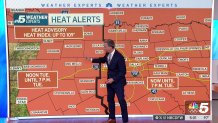Two heat advisories issued by the National Weather Service are expected to be extended throughout the week.
The NWS issued an advisory for dozens of counties in North Texas and Central Texas due to dangerously hot temperatures and high humidity.
Counties from Cooke, Denton, Tarrant and Johnson to the east are under a Heat Advisory until Tuesday at 7 p.m. Counties to the west will be under an advisory from noon Tuesday until 7 p.m.
The NWS said that the advisories are expected to be extended, and the heat will stay in the forecast throughout the week.
On Monday afternoon, NBC 5 Meteorologist Rick Mitchell said he expected temperatures to climb near 100 degrees from Tuesday through Saturday, with heat indexes in North Texas soaring to 105 degrees.

In some parts of the state, the NWS said heat indexes could feel as hot as 109 degrees.
The combination of heat and high humidity will increase the risk of heat-related illnesses, particularly for those working or participating in outdoor activities. The CDC discusses heat stroke, exhaustion, cramps, and other heat-related illnesses here.
HEAT SAFETY TIPS
With heat like this, you’ll want to take precautions and be prepared.
Drink plenty of fluids, stay in an air-conditioned room, stay out of the sun, and check up on relatives and neighbors to ensure they stay cool.
Young children and pets should never be left unattended in vehicles. According to the National Safety Council, if it’s 95 degrees outside a car’s internal temperature could climb to 129 degrees in 30 minutes. After just 10 minutes, temperatures inside could reach 114 degrees.
A child’s body temperature heats up three to five times faster than an adult’s, and heatstroke can begin when a person’s core body temperature reaches 104 degrees. According to the Texas Department of State Health Services, a core temperature of 107 degrees is lethal.
Take extra precautions if you work or spend time outside. When possible reschedule strenuous activities to early morning or evening. Know the signs and symptoms of heat exhaustion and heatstroke. Wear lightweight and loose-fitting clothing when possible. The Occupational Safety and Health Administration recommends scheduling frequent rest breaks in shaded or air-conditioned environments to reduce risk during outdoor work. Anyone overcome by heat should be moved to a cool and shaded location. Heatstroke is an emergency! Call 911. The CDC has more information on heat-related illnesses.
Take care of your pets by providing fresh, cool water and shade. Also, pets should not be left outside and unattended for too long. It’s too hot and they need to be brought inside.


